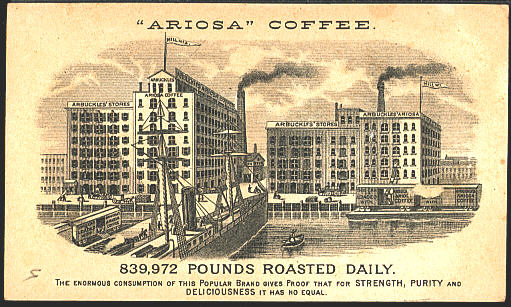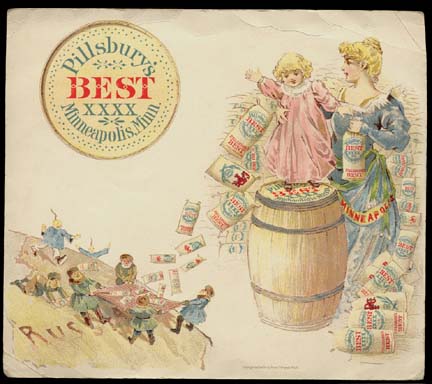 |
 Trade Cards - A brief history Trade Cards - A brief history
This section is dedicated to Trade Cards used by tradesmen and professionals to advertise their services in the late 1700s. Although examples from the early 1800s exist, it was not until the spread of color lithography in the 1870s that trade cards became plentiful. 
By the late 1800s, trade cards had become a major way of advertising America's products and services, and a trip to the store usually brought back some of these attractive, brightly-colored cards to be pasted into a scrapbook.
Some of the products most heavily advertised by trade cards were in the categories of medicine, food, tobacco, clothing, household, sewing, stoves, and agriculture.
The popularity of trade cards peaked around 1890, and then almost completely faded by the early 1900s when other forms of advertising in color, such as magazines, became more cost effective.
Although trade card collecting began over 100 years ago, today's strong interest in trade cards began relatively recently. Trade cards that were bought for ten cents thirty years ago frequently bring ten dollars or more in today's market--and some have even sold for over a thousand dollars.
Color printing of trade cards did not become widely popular in America until after the Civil War. In 1876, the Philadelphia Centennial Exhibition was a major venue for printers to hand out advertising of their card-production services. Though multi-colored cards had been in use for a while, this exhibition acted as a springboard for larger scale use of the multi-color trade card. Almost overnight, trade cards started appearing in every major city in America, especially in the East.
Over the next decade, trade cards began to appear in stores throughout the country. Addressing a wide variety of products from food to sewing machines to horse collars to axle grease, they became for a time nearly omnipresent. Since most households engaged in their own baking, sewing and farming, trade cards relating to these industries were found in great abundance.
Around the turn of the 20th century, technological advances made the distribution of newspapers and periodicals more practical and less expensive. Print advertising suddenly became more affordable and more widespread. The number of trade cards being produced started to plummet.
Trade Card Showcase.
 |
Anchor Line
Anchor Line was founded in 1856 as Handysides & Henderson although Handysides & Co. had owned ships prior to this date. In 1872 the Barrow Steamship Co. was formed in partnership with the Duke of Devonshire and ships were later transferred between Anchor Line and Barrow SS Co., but the two companies have been treated as one for the purposes of this list. In 1911 Cunard purchased the whole of the ordinary share capital of Anchor Line and in 1912 a joint service was formed to India with Brocklebank Line to be known as Anchor-Brocklebank. In 1916 Anchor-Donaldson Line was incorporated with Donaldson Line to operate services to Canada. The firm of Anchor Line went into liquidation in 1935, but extra finance was injected by Runciman Ltd and a new concern, Anchor Line (1935) Ltd was formed. Anchor-Donaldson and Anchor-Brocklebank ceased to exist and Cunard had no connection with the new company. In 1949 United Molasses Co (Athel Line) gained a controlling interest in the company and by the following year owned the whole ordinary share capital. The transatlantic passenger service ended in 1956, but in 1960 a new joint Anchor-Cunard service was introduced. United Molasses Co. became a subsidiary of Tate & Lyle in 1965 and Anchor Line was sold to Runciman & Co, Newcastle and in subsequent years several of Runciman's Moor Line ships were transferred to Anchor. The final passenger voyage to India took place in 1966. The Currie Line of Leith together with their fleet was acquired in 1969 and George Gibson, Leith in 1972. Anchor became the shipowning company for the group in 1976 and by 1986 all that remained of the company was five liquid gas carriers, technically owned by Gibson & Co. |
| |
 |
Ariosa Coffee
It was in the United States where coffee initially started to be commercialised. In 1865, John Arbuckle marketed the first commercially available packages of ground, roasted coffee. His brand, 'Ariosa', was sold over a far larger area then any other coffee roaster. Instead of being confined to a small area close to his roasting factory, Arbuckle was able to establish his coffee as a regional brand. Others soon followed suit and, by World War I, there were a number of regional roasters including companies such as Folgers, Hill Brothers, and Maxwell House. These companies offered customers consistent quality and convenient packaging for use in the home, but at a price: freshness. It could be several weeks, or even months, before the end product would reach the customer.
One approach to prolonging the freshness of roasted coffee was to glaze it with a glutinous or gelatinous matter. After the coffee beans had been roasted, a glaze would be poured over them, which would form a hard, protective barrier around the bean. Once such glaze patented by John Arbuckle in 1868, consisted of using: a quart of water, one ounce of Irish moss, half an ounce of isinglass, half an ounce of gelatine, one ounce of white sugar, and twenty-four eggs, per hundred pounds of coffee. Arbuckle experimented with many different glazes over the years, eventually settling on a sugar based glaze.
In fact, Arbuckle became such a prolific user of sugar that he entered into the sugar business rather then give a profit to others for the huge quantities he required. |
| |
 |
Pillsbury
Pillsbury is one of America's oldest and best-recognized names in food retailing.
In 1869, after working in his uncle's hardware supply company in Minneapolis, 27-year-old Charles A. Pillsbury bought onethird of a local flour mill for $10,000 and began the Pillsbury Company. Pillsbury and a competitor, the Washburn Crosby Company, formed the Minneapolis Millers Association that same year.
Pillsbury's improvements in milling machinery included the early incorporation of modern equipment for milling the very hard local wheat. These improvements and the purchase of two additional mills allowed him to produce 2,000 barrels of flour a day by 1872. That year he reorganized the company as C.A. Pillsbury and Company, making his father and uncle partners. In addition, he registered the trademark Pillsbury's Best XXXX in 1872.
During the 1880s Pillsbury added six more mills, including one that was then the largest flour mill in the world. This mill was equipped with state-of-the-art machinery, which more than tripled the company's output. Weakened by three mill fires in 1881, Pillsbury Company had just begun to recover, and was buying grain elevators to cut storage costs, when, in 1889, it sold the Pillsbury mills to an English financial syndicate. The syndicate also purchased competing Minnesota mills, elevators, and bordering water-power rights. Pillsbury remained as managing director of the new company, which was called the Pillsbury-Washburn Flour Mills Company Ltd. The company put its new water-power rights to use, and in 1896 the company passed the 10,000 barrel-per-day mark. Pillsbury-Washburn eventually grew, under Pillsbury's leadership, into the world's largest milling company. |
| |
 |
Tobacco Trade Cards
More than a century and a half ago there were no such rules or guidelines. There were no experts, no ad agencies, no pollsters. In the 1840’s, when cigar merchandizers began selling cigars in consumer size packages they became advertising pioneers. Concepts we take for granted today... pictures of babies and dogs will outsell images of turnips and dead goats... didn’t exist. It was the cigar industry, almost single-handedly, that experimented with images and text and discovered the rules that everyone follows today.
The cigar industry’s influence on advertising and packaging became huge because the level of experimentation exceeded that of any other product in history. Cigars were the only commercially retailed product made by more than a quarter million U.S. factories in which everyone was involved. Cigar factories created brands. Cigar brokers created brands. Cigar wholesalers created brands, Cigar retailers created brands. And, unlike ANY other product, cigar consumers, the smokers themselves, created brands. For a penny or two per 100, anyone could picture or say anything they wanted on a cigar box. Millions of people had ideas.
|
| |
|
|
|

